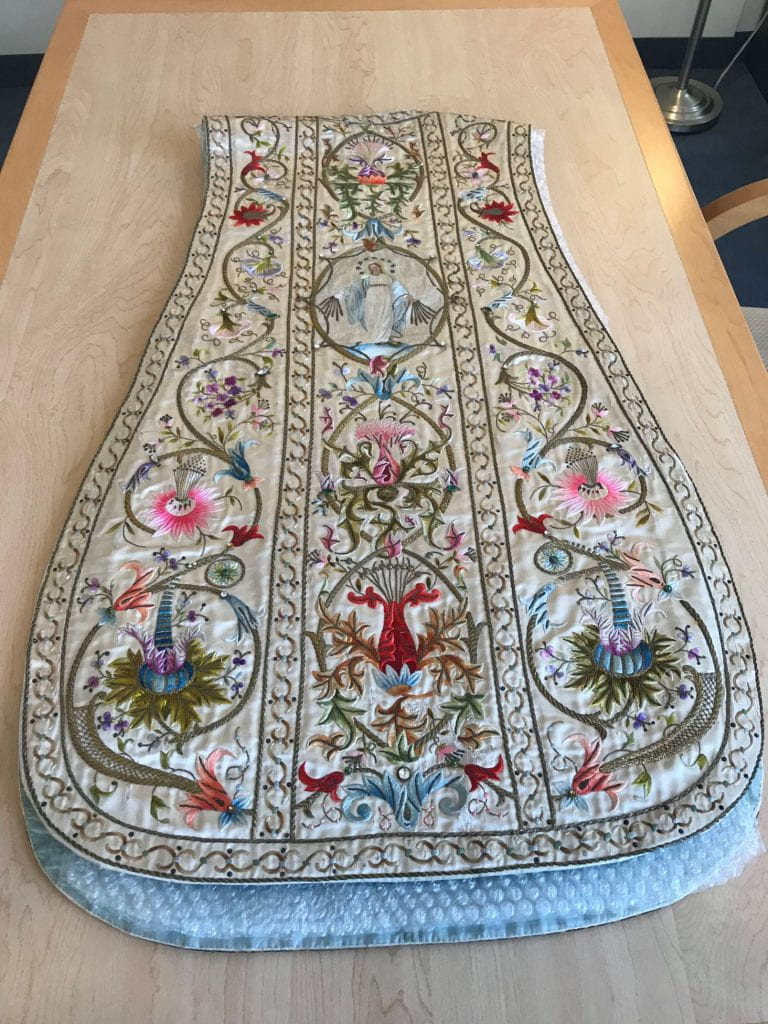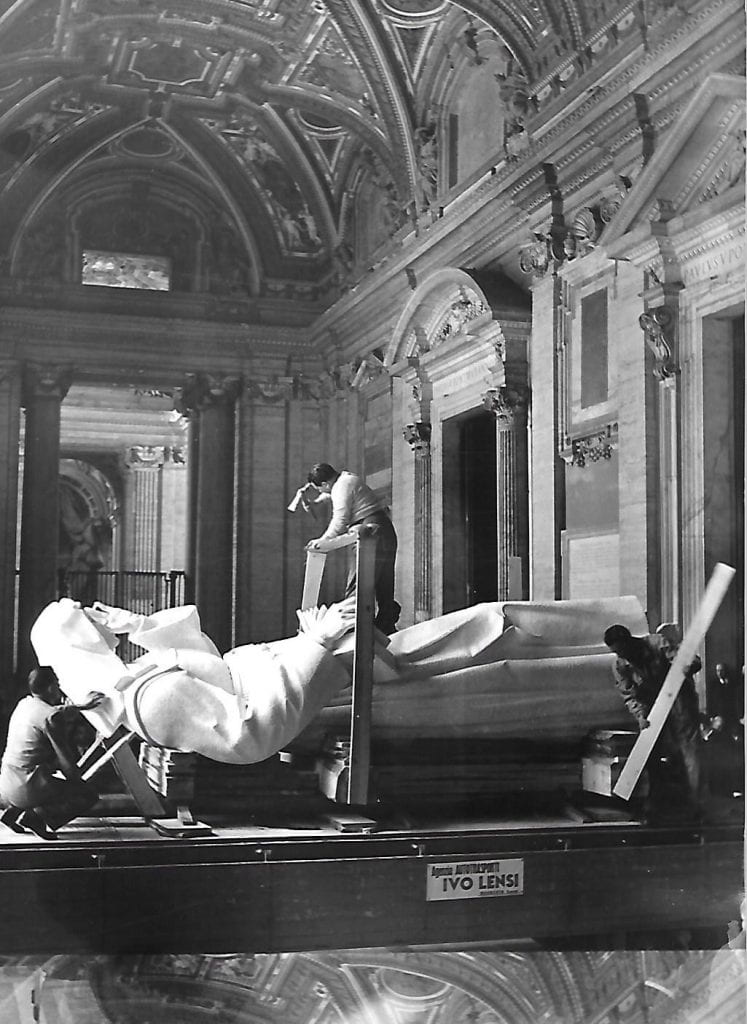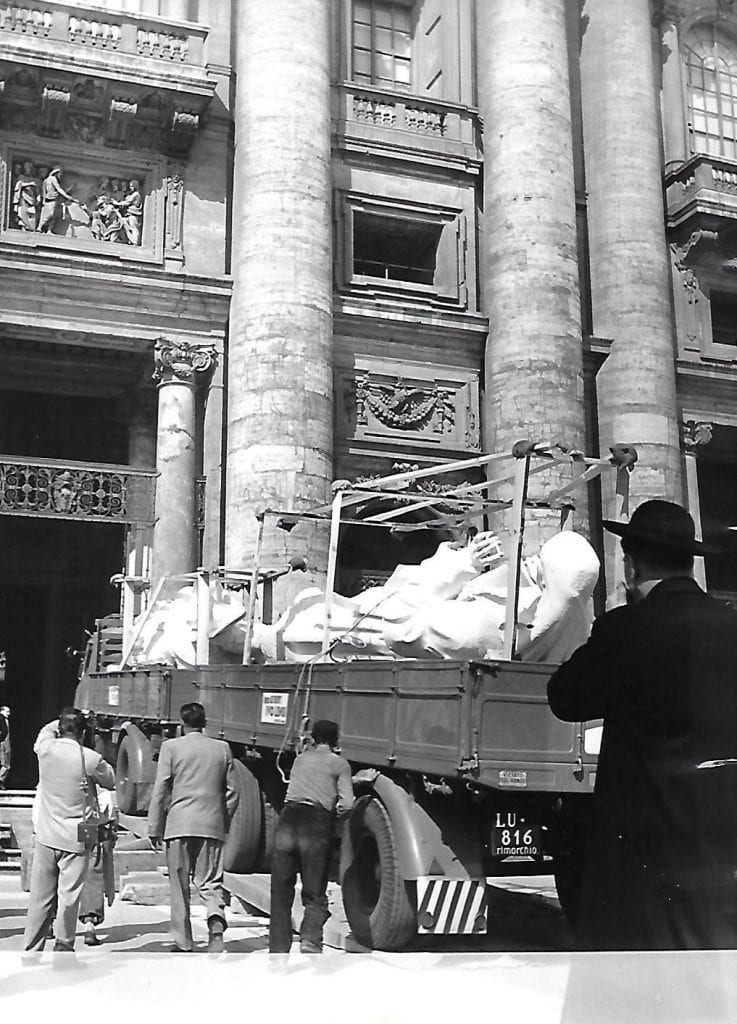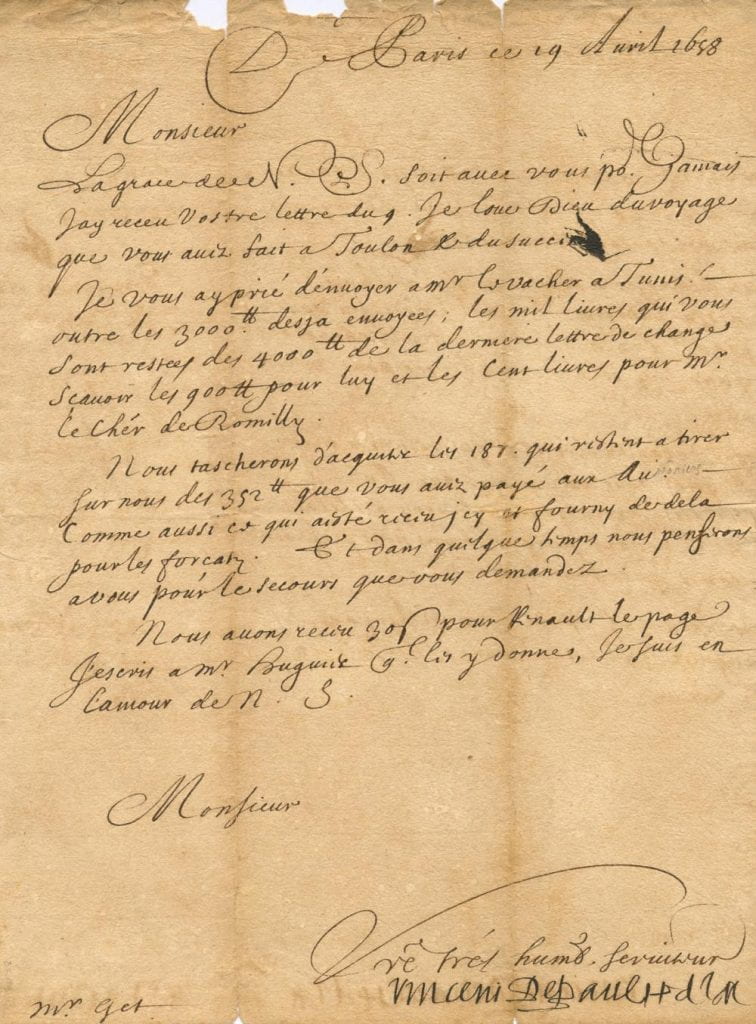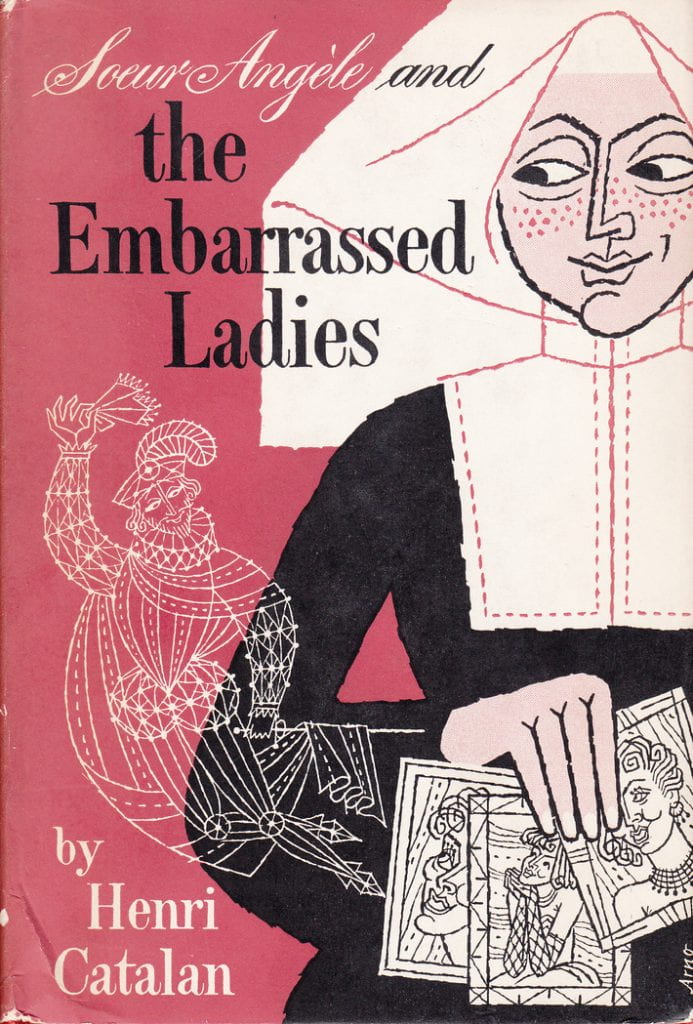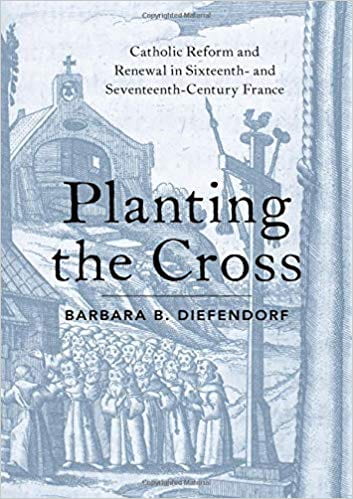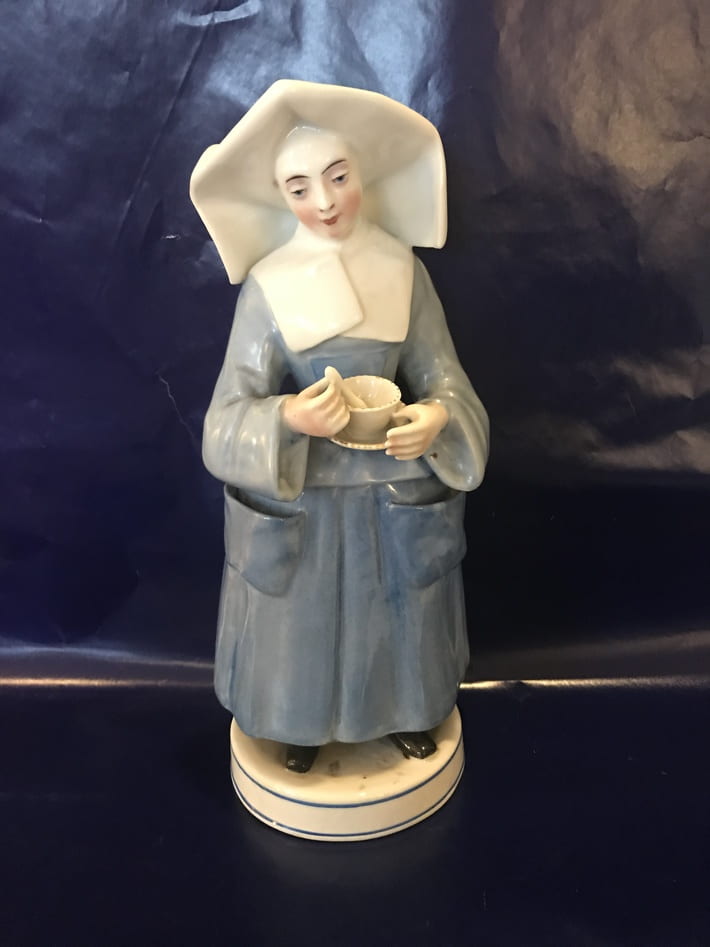The Vincentiana Art Collection of the Division of Mission and Ministry of DePaul University has recently acquired an early 20th century Spanish “fiddleback” chasuble. The beautiful white silk vestment has elaborate floral embroidery motifs, silver metallic and jeweled borders. The front of the vestment has a charming cartouche of Saint Vincent and two foundlings. The back side of the vestment has a cartouche of Our Lady of the Miraculous Medal.
Vincentian History
New Watercolor Acquired
The Vincentiana Art Collection of the Division of Mission and Ministry of DePaul University has recently acquired a charming 19th-century sepia watercolor of Saint Vincent de Paul with Foundlings by the 19th-century British author Hannah Mary Rathbone (b. 1798. d. 1878).
For more information about Rathbone’s life and literary career see her Wikipedia article: https://en.wikipedia.org/wiki/
Publication Notice: Saint: Vincent de Paul: His Perceived Christological Thought Pattern on Charity and Christ in the Poor.
Saint: Vincent de Paul: His Perceived Christological Thought Pattern on Charity and Christ in the Poor.
By
Michael I. Edem, C.M.
From the publisher:
“The entire work is divided into three parts. Each part has its accompanying chapters with corresponding introductions and conclusions. It is the incarnation that necessitated the self-emptying and self-abasement of Christ. It is the same mystery that underlies his passion and crucifixion and eventual resurrection. The mystery of incarnation capped with experiential events forms the tap root of this global vision of Christ in the poor. It is central to his theology of the poor, Christ in the poor and the poor in Christ. The incarnation and experiential events furnish the inclination and orientation Vincent’s thought pattern possesses. Such penetration and globalization process concerning the word “incarnate” are in line with the Church’s “permanent need of theological reflection.” The special inclination acts as a veneer that links other aspects. It forms a continuum, permeating and illumining the mystical link of the Vincentian Christ in the poor and the poor in Christ.”
- Hardcover: 686 pages
- Publisher: Xlibris Corp (February 14, 2019)
- Language: English
- ISBN-10: 1796015342
- ISBN-13: 978-1796015348
New Biography of Bishop John Dubois published
About the Author
Richard Shaw is a Catholic priest of the Albany, New York, diocese, and has degrees in American history and criminology. He has taught high school and is currently on his faculty of Maria College, Albany. Father Shaw is a chaplain at two county jails, and has been engaged in this ministry for ten years. In addition to published articles and short stories, he has written Dagger John: the Unquiet Life and Times of Archbishop John Hughes of New York; and The Christmas Mary Had Twins.
|
Product details · Paperback: 272 pages · Publisher: Wipf and Stock (May 10, 2018) · Language: English · ISBN-10: 1532645104 · ISBN-13: 978-1532645105 |
From the publisher:
“St. Elizabeth Seton called him “The Pope”; his students dubbed him “Little Bonaparte.” To Pope Gregory XVI he was “my most particular friend”; while his own Bishop charged him with acting as a “Bishop” rather than as parish priest. The man was Father John Dubois, an exile from France, the founding father of many cherished Catholic institutions in America. Dubois was beloved by the “little people”–the scattered Catholics he served in rural Maryland, Virginia, and Pennsylvania; and he was the amiable friend of Protestants such as James Monroe and Patrick Henry. In 1808 he began his “Mountain” seminary at Emmitsburg, Maryland, and 175 years later Mount St. Mary’s College still serves as his memorial to education. The founder would just as easily pick up an axe to fell lumber for his college buildings, as he would ride through the night on horseback to minister to the sick and dying. He called himself “an ugly little wretch,” but to his students (his children) he was fondly remembered as “old father.” Dubois’ great life’s work was his role as spiritual and physical architect of the Sisters of Charity in the United States. Without him, Elizabeth Seton might never have been known to history. This “American St. Vincent de Paul” wrote the first rule for the American sisters and pushed them out into missions across the country. Dubois was domineering, a tireless workman, often rough and blunt–not at all Mrs. Seton’s choice as a religious Superior. In 1826 the labors of the benevolent dictator ended at Emmitsburg, and he was called to head the immigrant church in New York. John Dubois became bishop of a turbulent diocese, dominated by fiercely nationalistic clergy and laity–“chiefly Irish.” Despite his good will, and although dedicated to all that was “chiefly American,” the French emigre remained a foreigner to his people in New York City. Embattled for sixteen years with insolent clergy and powerful lay trustees, the Bishop shunned public controversy and concentrated on pastoral care. He made frequent visits to the missionary territory in upstate New York, worked through cholera epidemics and went on a begging tour in Europe. In the 1830s, Protestants were beginning to react violently to Catholics and the immigrant Irish, yet Dubois was respected by numerous non-Catholics. He was also a friend to important Catholics: Roger Taney, Charles Carroll, Pierre Toussaint, the black philanthropist, and Mark Frenaye. He had enough faith in one young immigrant to ordain him and give him his start in America: St. John Neumann. As an old man, incapacitated by a series of strokes, he was sadly ignored by his energetic auxiliary, Bishop John Hughes. Before Bishop John Dubois died in 1842, he requested: “Bury me where the people will walk over me in death as they wished to do in life.” Ironically, his gravesite was “lost” for well over 125 years. Now, the stirring and inspiring life of John Dubois is recaptured in his first full-length biography. The author finds Dubois a great and holy man–truly worthy of the title “Founding Father.””
Louise de Marillac enters St. Peter’s Basilica
The Vincentian Studies Institute recently purchased two photographs from February 1954 that capture the delivery of the monumental statue of Saint Louise de Marillac to Saint Peter’s Basilica in Rome. Louise’s canonization took place in 1934. Her statue became the thirty-ninth and last, to fill one of the internal niches of St. Peter’s. The sheer size of the sculpture emerges in scale against the figures of the various workers. The photographs will join the Vincentiana collection at the Archives and Special Collections Department of DePaul University’s, John T. Richardson Library.
DePaul University Purchases Letter written by Saint Vincent de Paul
The Vincentian Studies Institute of DePaul University recently purchased a Vincent de Paul Letter. The letter is from the saint to Firmin Get an early Lazarist who at the time was superior of the house at Marseilles. The letter is dated from Paris, April 19, 1658. This is a previously known letter numbered #2574 (volume 7) by Pierre Coste, C.M., in his multi-volume “Correspondence, Conference, Documents” collection. The saint’s secretary Brother Bertrand Ducournau wrote the letter from dictation. The piece is signed by Vincent. This letter will join the growing collection of Vincent manuscript letters and documents at the Archives and Special Collections Department of DePaul University’s, John T. Richardson Library.
Newsnote: Saint Vincent de Paul Society Centennial Holy Card (1833-1933)
The Vincentiana collection at the Archives/Special Collections Department of DePaul University’s John Richardson LIbrary has recently acquired this example of a holy card celebrating the centennial (1833-1933) of the foundation of the Society of St. Vincent de Paul.
The image shows Frederic Ozanam ministering to the poor in whom he finds Christ. His work is blessed and inspired by Saint Vincent de Paul.
Newsnote: Soeur Angele: Daughter of Charity Detective Novels
“Soeur (Sister) Angèle must have been the first nun-detective in fiction. She is a Sister of Charity (an order, we are told, founded by Vincent de Paul) but is also a medical doctor, attached at first to the French hospital and orphanage in Bethlehem, although we never see her there. She had previously been Dr Angèle Persent d’Ericy, before she had decided to become a nun. “She was of medium height …. Her face, freckled and lit up by two sparkling humorous eyes, was attractive. It fairly radiated intelligence and good will. She held herself very straight …. You knew that she was both kind and intelligent”. She has “a sort of evangelical candour and purity of motive” and “an incurable idealisation of the moral quality of other people”. Or, as her old professor put it, “You’re still the same self-opinionated little devil” She nearly always carries “a large black bag (“there seemed nothing her enormous bag did not contain”) and an immense umbrella” – although, by the second book, the color of the bag and umbrella seems to have changed to slate blue to match her habit.
She was created by the French author Henri (Henry in the English editions) Catalan whose real name was Henri Dupuy-Mazuel (1885 – 1962), who was the author of numerous novels, short stories and screenplays for silent films, and producer of the film Le Tournoi (The Tournament) that was directed by Jean Renoir in 1929. He used the pseudonym Henry Catalan for his Soeur Angèle novels.”
At least three of Catalan’s “Soeur Angele” detective stories were published in English. Both French and English editions are long out of print, but are easily available from sites like Advanced Book Exchange.
Newsnote: Barbara Diefendorf’s latest book to be published on March 15, 2019
“The first thing that Catholic religious orders did when they arrived in a town to establish a new community was to plant the cross–to erect a large wooden cross where the church was to stand. The cross was a contested symbol in the civil wars that reduced France to near anarchy in the sixteenth century. Protestants tore down crosses to mark their disdain for “popish” superstition; Catholics swore to erect a thousand new crosses for every one destroyed. Fighting words at the time, the vow to erect a thousand new crosses was expressed in the rapid multiplication of reformed religious congregations once peace arrived. In this book, Barbara B. Diefendorf examines the beginnings of the Catholic Reformation in France and shows how profoundly the movement was shaped by the experience of religious war. She analyzes convents and monasteries in three regions–Paris, Provence, and Languedoc–as they struggled to survive the wars and then to raise standards and instill a new piety in their members in their aftermath. What emerges are stories of nuns left homeless by the wars, of monks rebelling against both abbot and king, of ascetic friars reviving Catholic devotion in a Protestant-dominated South, and of a Dominican order battling demonic possession. Illuminating persistent debates about the purpose of monastic life, Planting the Cross underscores the diverse paths religious reform took within different local settings and offers new perspectives on the evolution of early modern French Catholicism.” About the Author Barbara B. Diefendorf is Professor Emerita of History at Boston University. She is the author of From Penitence to Charity: Pious Women and the Catholic Reformation in Paris (OUP, 2004), winner of the J. Russell Major Prize of the American Historical Association, and Beneath the Cross: Catholics and Huguenots in Sixteenth-Century Paris (OUP, 1991), winner of book awards from the New England Historical Association and National Huguenot Society, among other titles. Product details Hardcover: 232 pages Publisher: Oxford University Press (March 15, 2019) Language: English ISBN-10:
Newsnote: 19th century Daughter of Charity Tisaniere acquired
The Vincentiana Collection in the Archives/Special Collections Department of DePaul University’s Richardson Library recently acquired this rare example of a mid to late 19th century French porcelain tisaniere (teapot) molded in the figure of a Daughter of Charity. This quaint example illustrates the popularity of the Daughters of Charity as the proto-typical “bonne soeurs” of 19th century France.
